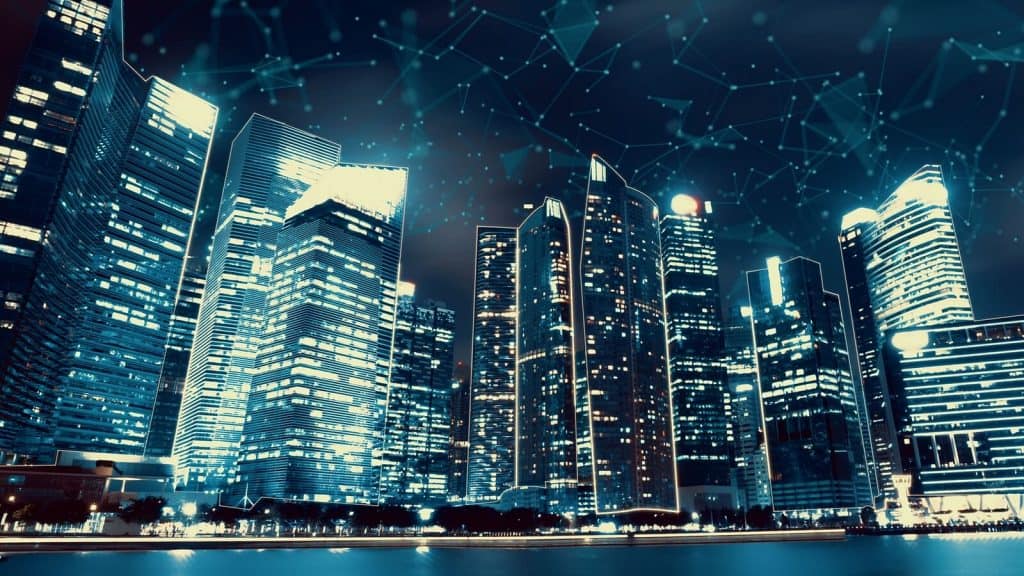Heralded as the future of cities, smart city solutions are quickly gaining traction. The global population is expanding rapidly, and an increasing number of people are moving to cities searching for employment and income opportunities. The United Nations estimates that 68% of the global population will live in cities by 2050. But, already, most people in the developed world, in the United States, Europe, and much of Asia, live in cities. Only Africa remains primarily rural, and that scenario is changing fast.
Unfortunately, urbanization comes with a host of challenges. Cities are often ill-prepared for the influx of people. Today, many urban areas are grappling with mobility challenges, pollution, high energy requirements, dilapidated or inadequate infrastructure, lack of social amenities, runaway crime, and a host of other challenges that piggyback on urbanization.
Cities have no choice but to smart city solutions to solve these problems. But, where does a city begin? Becoming a smart city isn’t merely about giving everyone free wi-fi or installing CCTV cameras; it’s much more complicated than that. A smart city is an ecosystem of connected parts that work in tandem to deliver a better quality of life for its residents.
We suggest the following ten smart city solutions to consider when implementing smart city initiatives.
- Data
Smart cities leverage data to make intelligent decisions that lead to positive outcomes for the residents. City officials must begin by considering what data they need, how they will collect it, analyze it, store it, and how long they need to keep it. The staff must have the right skill set to make sense of data and use various data tools in their everyday work.
In urban planning and development, historical trends are vital to forecasting the future. The smart city solutions chosen in this regard must therefore have redundant backups in the cloud and off-site.
Also, city officials must decide what data they want to retain and for how long. Smart city infrastructure can generate massive amounts of data within a short time. For example, the average smart car generates four terabytes of data daily. Some of this data will only be useful for a limited time and should be discarded. Also, as camera quality improves, video and image footage will need extensive storage. Officials need to come up with clear policies that govern how storage space is released.
- The Network
Data is the foundation, but the network is the walls that give structure to a smart city. The network allows you to manipulate your data. It must be fast and support a large number of devices within small spaces. This is where 5G technology comes in.
5G smart city solutions are a key ingredient for smart cities. 5G is the fifth generation of mobile networks and a significant improvement of the current 4G LTE networks in most parts of the world today. This technology delivers faster connections and greater capacity. 5G URLLC (Ultra-Reliable Low Latency Communications) systems have a response time of 1 millisecond compared to 20-30 milliseconds for 4G LTE systems. Using ‘massive’ MIMO (multiple input, multiple output) antennas, 5G technology can simultaneously connect a high number of users and maintain high throughput. This is in contrast to 4G LTE systems that lag when many users and devices connect to the network simultaneously and useful feature for smart cities where many devices and users will connect to the networks simultaneously.
5G is handy for camera footage that has high bandwidth requirements.
- The Internet of Things (IoT)
5G networks operationalize the Internet of Things (IoT). IoT smart city solutions refer to the ubiquity of devices, gadgets, and equipment that collect data and are Internet-enabled. It encompasses items that we would not ordinarily expect to be connected to the Internet, such as lampposts collecting weather and traffic information, stormwater sewer meters detecting clogging and large foreign matter, and doorknobs that detect pathogens and log the results to a remote server. IoT collects the data that the city uses to make smart decisions. Such devices also require batteries to remain constantly connected to the Internet and relay the information they collect. There are tremendous technological strides in battery life, but one way a city lacking 5G technology can solve this problem is to use a low-power wide-area network (LPWAN) protocol.
- Modular infrastructure
IT infrastructure in a smart city must be kept up-to-date. Vulnerabilities must be discovered before they are exploited and patched. The software must also be patched and devices replaced with minimal interference. The only way to do this is to have a modular setup where maintenance operations can be carried out on a network section without having to shut down the entire system. Additionally, modular infrastructure can be scaled up or down as needed.
- Security
While smart city solutions help solve the urbanization problems, they also introduce significant security risks in the event hackers gained control of IoT devices, infrastructure, and facilities. In a connected world, doomsday scenarios such as planes falling out of the sky, trains crashing into each other, and autonomous vehicles running amok are not far-fetched.
Security in a smart city calls for a vigilant approach. Administrative access to systems must be tightly controlled using multiple verification methods such as passwords, biometric controls, app passwords, and QR codes.
City officials should hire ethical hacking companies that look for vulnerabilities around the clock to close before hackers get wind of it. City staff also need regular security training and refresher training since most successful hacks result from social engineering techniques.
- Privacy
Loss of data privacy is another potential consequence of smart city solutions. For a city to operate as intended, the citizens must agree to share some data with the city. This data includes their location, the services they use, where they shop, how they commute, what they eat, and much more. The city analyzes this data and uses it to improve the quality of life. However, this data could fall into the wrong hands and be used to target people in unfair ways. For example, racially motivated city officials could use this information to discriminate during service delivery. People’s data can also be stolen and used for commercial purposes without their consent or for blackmail.
To mitigate against these adverse outcomes, data privacy laws that reflect the people’s will must be enacted by their representatives in legislative bodies. Regulations such as the European’s Union’s General Data Protection Regulation (GDPR) are a good pointer of the legal direction smart cities should take to protect citizen data.
- Sensors and Data Capture
Many smart city officials are unaware of the challenges associated with implementing smart city solutions. For example, people tend to talk about data capture without specificity. Failure to be specific means data can potentially include everything, noise pollution
pollen, road surface temperatures, sewage flow rates, soil moisture, valve pressure, water quality, wildlife, wind direction, and anything else that can be captured.
Sensors and data capture smart city solutions are specific in what they capture. For example, The City of Philadelphia has a crowdsourced app that helps drivers find free parking and navigate the Philadelphia Parking Authority’s parking rules. Boston protects bikers and pedestrians by analyzing all sorts of traffic data while New York’s automated water reading system streamlines billing and monitoring.
- Distributed Data Processing
Data collection is essential, but equally important is data processing. As already mentioned, not everything you collect ends being useful. It is important to filter what you send to your cloud storage. In a distributed data processing setup, a central computer works with networked computers to process data. This setup allows different systems, for example, traffic management, to respond faster without having to “ring” home for every decision.
- Start Small and Expand
Implementing smart city solutions is a massive project with many moving parts. Biting more than you can chew can lead to project delays, mistakes, and abandonment. The smart city graveyard is littered with many promising projects that didn’t take off as expected due to poor planning and execution. For example, Google affiliate Sidewalk Labs recently abruptly abandoned the Toronto smart city project due to unpredictabilities caused by the COVID-19 pandemic that made the project financially unviable.
In order to avoid false starts and failures, it is best to chop up the project into smaller sub-projects and milestones. The completion of each part moves the city closer to full smart city status. City officials can begin by prioritizing the city’s problems and starting with smart city solutions that solve the most immediate issues. Think of a smart city initiative as a snowballing process that starts small and gains momentum gradually.
- De-silo Departments
Public administrators globally are not known to be as innovative, open to new ideas, or collaborate as their private companies’ counterparts. Individuals can become quickly territorial when they perceive a piece of technology or a new way of doing things as infringing on their turf.
Such siloed mentalities often throttle the progress of smart city initiatives and must be nipped in the bud. Departments must collaborate and share data for the project to be a success.
The city may need to hire a management consultant to train staff on smart city solutions’ benefits and use team-building exercises to get everyone on board.

